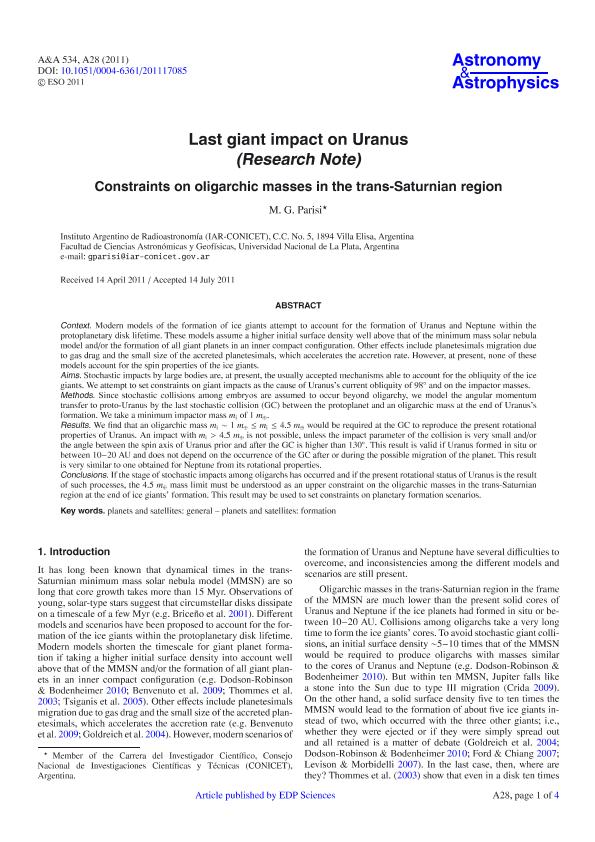Artículo
Last giant impact on Uranus: constraints on oligarchic masses in the trans-Saturnian region
Fecha de publicación:
07/2011
Editorial:
EDP Sciences
Revista:
Astronomy and Astrophysics
ISSN:
0004-6361
Idioma:
Inglés
Tipo de recurso:
Artículo publicado
Clasificación temática:
Resumen
Context. Modern models of the formation of ice giants attempt to account for the formation of Uranus and Neptune within the protoplanetary disk lifetime. These models assume a higher initial surface density well above that of the minimum mass solar nebula model and/or the formation of all giant planets in an inner compact configuration. Other effects include planetesimals migration due to gas drag and the small size of the accreted planetesimals, which accelerates the accretion rate. However, at present, none of these models account for the spin properties of the ice giants.
Aims. Stochastic impacts by large bodies are, at present, the usually accepted mechanisms able to account for the obliquity of the ice giants. We attempt to set constraints on giant impacts as the cause of Uranus’s current obliquity of 98° and on the impactor masses.
Methods. Since stochastic collisions among embryos are assumed to occur beyond oligarchy, we model the angular momentum transfer to proto-Uranus by the last stochastic collision (GC) between the protoplanet and an oligarchic mass at the end of Uranus’s formation. We take a minimum impactor mass mi of 1 m⊕.
Results. We find that an oligarchic mass mi ~ 1 m⊕ ≤ mi ≤ 4.5 m⊕ would be required at the GC to reproduce the present rotational properties of Uranus. An impact with mi > 4.5 m⊕ is not possible, unless the impact parameter of the collision is very small and/or the angle between the spin axis of Uranus prior and after the GC is higher than 130°. This result is valid if Uranus formed in situ or between 10 − 20 AU and does not depend on the occurrence of the GC after or during the possible migration of the planet. This result is very similar to one obtained for Neptune from its rotational properties.
Conclusions. If the stage of stochastic impacts among oligarchs has occurred and if the present rotational status of Uranus is the result of such processes, the 4.5 m⊕ mass limit must be understood as an upper constraint on the oligarchic masses in the trans-Saturnian region at the end of ice giants’ formation. This result may be used to set constraints on planetary formation scenarios.
Palabras clave:
Planets And Satellites: General
,
Planets And Satellites:Formation
Archivos asociados
Licencia
Identificadores
Colecciones
Articulos(IAR)
Articulos de INST.ARG.DE RADIOASTRONOMIA (I)
Articulos de INST.ARG.DE RADIOASTRONOMIA (I)
Citación
Parisi, Mirta Gabriela; Last giant impact on Uranus: constraints on oligarchic masses in the trans-Saturnian region; EDP Sciences; Astronomy and Astrophysics; 534; A28; 7-2011; 1-4
Compartir
Altmétricas




